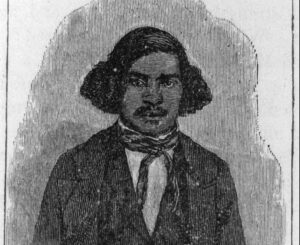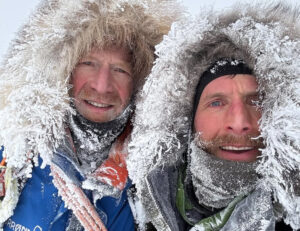A while back, I was gazing at a bronze plaque pegged into a diabase cliff on South Quadyuk Island in the Kitikmeot region of Nunavut. The plaque contained these words: IN MEMORY OF THOMAS GEORGE STREET OF OTTAWA AGE 23 YEARS WHO DIED GOING TO THE AID OF HIS FRIEND JULY 12, 1912.
Street did not die going to the aid of his friend. Quite the contrary. But let’s go back a bit in time. Born in 1885, Street had a demanding, quick-to-anger father who condemned his almost every act. Not surprisingly, he grew up with a deep respect for authority. At the same time, he tried to escape authority by canoeing and hiking in Ontario’s backcountry. Rumor has it that he could carry a load of 200 pounds on his back while walking on muskeg, no problem.
In 1911, Street was working as a general utility man for a surveying party in Smith’s Landing, Alberta, when an American named Harry Radford appeared on the scene. Radford claimed to be an explorer, indeed a highly acclaimed one, although he had done most of his exploring in upstate New York’s Adirondack Mountains. Hence his nickname, “Adirondack Harry.”

Harry Radford. Photo: Canada Monthly
The proposal
Might Street be interested in a 5,000-kilometer, two-year Barren Ground expedition? Radford wondered. Of course, he, Radford, would get the lion’s share of food if their supply ran short, and he’d also have exclusive rights to publishing the story of the expedition. Street immediately agreed to accompany Radford even though his coworkers in Smith’s Landing thought he was “plumb crazy” to do so, and the local Royal Canadian Mounted Police (RCMP) Corporal Mellor declared, “The gentleman is utterly helpless.” He was referring to Radford, not Street.
The Yukon bard Robert Service encountered the two men on a Hudson’s Bay Company steamship on the Slave River en route to Fort Resolution. Radford, he wrote in his memoir Ploughman of the Moon, “was pushed by the idea of exalting himself in his own eyes if not in the eyes of the public,” while Street was both “waterwise and woodwise.” John Hornby and George Douglas also happened to be on the ship. Had these individuals accompanied Radford and Street, their expedition probably wouldn’t have come to such an unpleasant end.

George Street. Photo: Saskatchewan Archives
Radford’s temper
At Fort Resolution, a nun gave Street a bottle of Holy Water to protect their expedition from storms…actual storms rather than Radford’s periodic temper tantrums. The two men paddled their 19-foot Peterborough canoe east to Artillery Lake, then along the Hanbury and Thelon Rivers and north to Chesterfield Inlet, with Street doing all of the portaging. They hoped to reach Bathurst Inlet before the onset of winter but got only as far as Schultz Lake. Here, they lodged in the multi-chambered igloo of the chief, an Inuk named Akulak.
Unlike Radford, Street spent a good deal of time hanging out with the local Inuit. Posted from Chesterfield Inlet, his letters to his family suggest a genuine interest in Inuit culture. Here are two snippets from them:
“Eskimo children never quarrel or cry, and their parents never reprove or punish them. In fact, they [the Eskimos] are the most contented people you can imagine.”
“The reason Akulak gave me for not wanting to die was that he wouldn’t be able to eat anymore. Especially not eat any more deer [caribou] tongues.”
In the spring, Radford hired a guide, an Inuk named Bosun, for the sledging trip to Bathurst Inlet, but Bosun bowed out when Radford refused to provide for his family during his absence. An angry Radford reached for his rifle and threatened to shoot the fellow if he didn’t become the trip’s guide. “Go ahead and shoot,” Bosun said, and Radford put down his rifle. A portentous moment.
Somber news
Finally, Akulak agreed to guide them to Bathurst Inlet, and they made the
six week trip without incident. Upon arriving at their destination in early May,
Radford immediately began mapping what he called “the last strip remaining unexplored on the continental coast of North America.” He didn’t get very far into mapping that strip, however, because on June 11, 1913, Akulak arrived at the Hudson Bay Company trading post in Chesterfield Inlet and told H.H. Hall, the post’s
manager, that Radford and Street had been murdered by the Bathurst Inlet Inuit.
Nowadays the RCMP could fly to Bathurst Inlet to investigate the murders, but not in those days. An overland patrol led by Inspector Francis French underwent all sorts of obstacles and arrived at Bathurst Inlet five years after the murders occurred. Upon their arrival, members of the patrol raised their hands high above their heads, the traditional friendly greeting among northern Inuit.
After taking depositions from ten men and women, French decided not to prosecute the culprits, since native people were not subject to the same laws as other Canadians. But he told the local Inuit that if they killed any more white men, the killer/killers “would be taken away and never be allowed to return.” This was the worst of all possible threats since most Inuit would rather be executed than taken away from their Arctic homeland.
How the murders went down
Lay missionary and explorer W.H.B. “Billy” Hoare had visited Bathurst Inlet before Inspector French and described the murders in a letter to Street’s family. He wrote that an Inuk named Kaniak had agreed to guide Radford and Street, but Kaniak changed his mind when his wife fell on the ice, and he needed to look after her. Radford went berserk and tried repeatedly to dunk Kaniak in the icy sea. Before he could drown Katiak, another Inuk, Hulalak, stabbed Radford three times in the small of the back with sharp, double-edged knife, then cut his throat so he would die quickly.

Hulalak. Photo: NWT Archives
“Street tried to stop Radford,” Hoare wrote in his letter, “and since he had no luck in doing this, he went to his sled and started off a little with it. Hulalak and a man named Amelgeanik ran up, caught him, and stabbed him because they were afraid the white people would come and finish them [the Inuit] all off if he got away and told the authorities what happened to Radford. Both bodies were thrown into the sea. The Eskimos all say Street was a good man.”
Rasmussen’s testimony
In Across Arctic America, Rasmussen wrote that he’d “lived for a month
with the two murderers…and found them both kindly, helpful, and affectionate;
thoroughly good fellows all around.” Amelgeanik himself was deeply upset that he’d killed Street, so deeply upset that he later gave Hoare his three finest white fox pelts and told him to give them to Street’s family, which Hoare did. I asked Street’s half-sister Eleanor Hart (nee Street) Golden whether she remembered seeing the fox pelts around the house. “Yes,” she told me. “We kept them for a while, but they went bad, and we had to throw them away.”
Let’s return to the plaque. As you now know, Street was going away from his friend, not to his aid, and likewise that so-called friend was a father figure morphed into a crazed expedition leader. A pity Street didn’t get very far from Radford, for if he did, he might have become a well-known Arctic explorer, or perhaps more likely, a guide for well-known Arctic explorers. Dare I say that such guides are often better explorers than the explorers themselves?
Thanks to Sheila Thompson, who provided me with copies of letters from her father W.H.B. Hoare, and to Eleanor Hart Golden, who gave me copies of the letters her half-brother George sent to his family.






